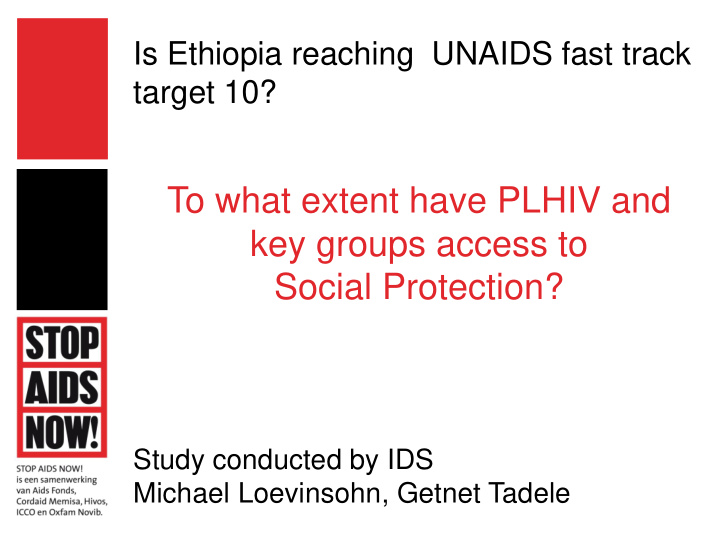



Is Ethiopia reaching UNAIDS fast track target 10? To what extent have PLHIV and key groups access to Social Protection? Study conducted by IDS Michael Loevinsohn, Getnet Tadele
Four study groups: People Living with HIV (PLHIV) Member of key groups: people at high risk, and people affected by hiv (MKG) People with disabilities (PWD) People not living with HIV or major disabilities. (PND) 4 study sites: Addis Ababa, Goba, Debre Eliyas, Fincha Survey questionaire (N=304), FGDs (N=123) and KI (N=52) 38% respondents members of COP or other NGO 1-6-2016
Research questions 1. What are the social protection programs that are available and for which PLHIV and key groups are eligible? 2. To what extent are PLHIV and key groups actually accessing these social protection programs? 3. What are the obstacles PLHIV and key groups face in accessing social protection programs? 4. How useful do PLHIV and key groups find the state social protection programs they are able to access? To what extent do the COP’s programs complement those 5. of state social protection and how can that be improved for the benefit of PLHIV and key groups? 1-6-2016
Availability programs 12 social protection programs identified in national policy State-administered social protection programs (48%): Provision of basic services Support to vulnerable children Support to persons with a disability Employment promotion NGOs (43%) and CBOs (10%) 1-6-2016
Accessing social protection programs 37% of respondents do not receive support from any program PLHIV 11% MKG 54% Average program obtained: PLHIV: 2 programs PWD: 1.3 programs MKG and PND: 0.9 programs 1-6-2016
100 Attempt rate Success rate 90 80 70 60 50 % 40 30 20 10 0 PLHIV MKG PWD PNHD Member Non- member Figure 12. Attempt and success rates in accessing social support programs by group and by membership status. The rates are defined in the text. 1-6-2016
Membership advantage Members access 2.1 programs Non-members access 0.73 programs 57% of non-members access no social protection programs at all. More programs available More attractive and accessible services More empowered Members of NGOs are more succesful in accessing state-led Social Protection programs
2.5 2 1.5 Programs (number) Member Non-member 1 0.5 0 PLHIV MKG PWD PNHD Total Mean number of programs respondents successfully accessed of the four that are provided in Goba and Addis Ababa-Bole by Government, without NGO involvement. N (members/non-members): PLHIV (26/16), MKG (17/21), PWD (14/6), PNHD (27/49). 1-6-2016
Obstacles accessing programs Effective unavailabity of social protection programs Lack of Information (not knowing procedures, where to go to) Lack of Awareness of Rights and Low Confidence Unrealistic / not clear eligibility/ inclusion criteria Bad understanding needs of target group Stigma and discrimination 1-6-2016
How to reach fast track target 10? Assess social protection policy Reconsider eligibility criteria Increase awareness of social protection Extend availability of social protection Improving government-NGO collaboration : “ membership advantage” 1-6-2016
Recommend
More recommend